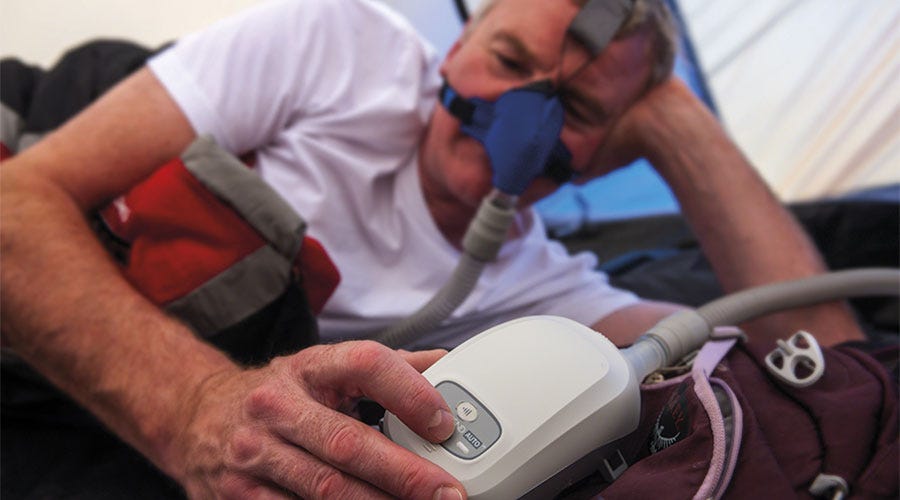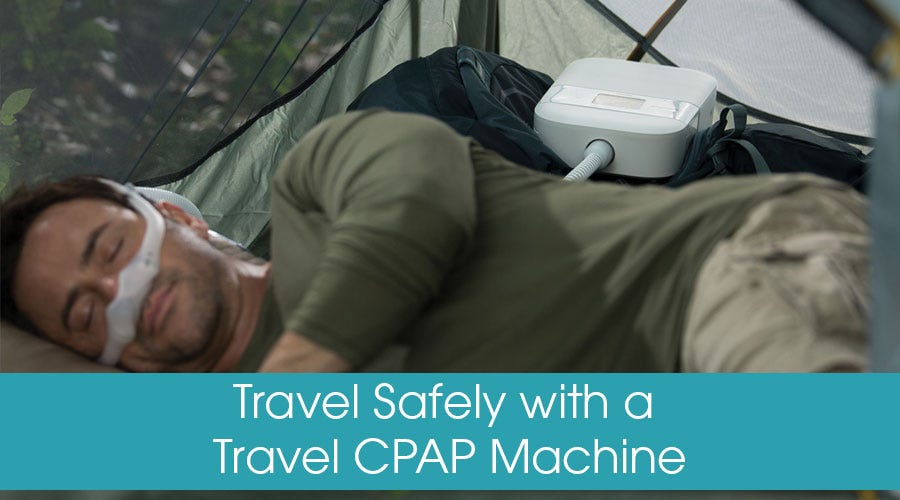If you have obstructive sleep apnea (OSA) and use a continuous positive airway pressure (CPAP) machine at home, it is a challenge to continue your CPAP therapy while traveling. Many patients who use CPAP machines might be tempted to leave their devices at home and go without it during their trip. However, there can be serious complications associated with sleep apnea, and it is not recommended to discontinue your therapy, even if it is only for a few days.
In this blog post, we will discuss how easy it is to continue your CPAP therapy while traveling with a travel CPAP machine and provide some tips to consider before purchasing one.
Do You Need a Travel CPAP Machine?
Most people who have OSA already use a CPAP machine at home every night, so the idea of purchasing another device to use while traveling might seem a bit over the top. However, one of the reasons why companies developed the travel CPAP machine is because home CPAP machines can be bulky and are not easily transported or placed in a carry-on bag when flying. So to avoid the temptation to discontinue CPAP therapy while traveling, smaller and more portable CPAP machines were developed.
That said, it is not a requirement to have a travel CPAP machine to travel. If you are fine with putting your home machine in a checked bag or requesting to bring it carry-on, that is perfectly acceptable. However, there are several benefits to having a travel CPAP machine in addition to a home machine:
- The Tubing is Smaller Than a Home Device
-
- Travel CPAP machines use tubing that is generally smaller and more flexible. The smaller tubing makes it easier to store in a carry-on bag and is more flexible for more natural movement during sleep.
-
- They Are Battery-Powered
Newer travel CPAP machines are powered by both a power cable or a battery pack, so you can be truly wireless if you need to use your CPAP while camping where outlets are not readily available.
- They Are Battery-Powered
-
- They Are Quiet
With most travel CPAP machines coming in at 25–30 decibels, they are just as quiet as rustling leaves and even quieter than library ambiance.
- They Are Quiet
- Perfect for Frequent Travelers
If you are a frequent traveler, having a travel option for your CPAP therapy is essential to the overall success of your treatment. The more days you can continue your therapy, even while traveling, the better it will be for your long-term health.
As mentioned above, you can still travel with your home CPAP machine, but there are distinct advantages to owning a travel CPAP, especially if you are a frequent traveler. The remainder of this article assumes that you are considering purchasing a travel CPAP machine, but many of the following travel tips are applicable if you will be traveling with either a travel machine or your home machine.

Considerations Before Purchasing a Travel CPAP Machine
Before you purchase a travel CPAP machine, there are several things to keep in mind:
- Go for Quality
-
- When it comes to medical devices, it is better to invest in a high-quality device. Making cost the deciding factor may result in getting a lesser device that cannot meet your needs. This does not mean you have to purchase the most expensive machine either. However, it is undoubtedly essential to consider the customer reviews and the clout of the company when comparing devices in addition to the cost. CPAP machines are generally used for a long time, so you will want to get the most life out of your device as possible.
-
- Consider Your Carry-On Bag Size
If you have a go-to bag that you use as a carry-on, consider how easily your travel CPAP machine will fit into that bag. Many travel CPAP machines are small enough to take up a small area of your bag, but you will want to verify that beforehand. Alternatively, if you properly label your CPAP machine as a medical device, it will not be considered as your allotted carry-on bag in the first place and can be stored separately as a carry-on.
- Consider Your Carry-On Bag Size
-
- Consider Your Current Mask Compatibility
If you already have a home CPAP machine with a mask that you prefer, check to see if the travel device you will be purchasing is compatible with your mask. Most travel CPAP machines are compatible with different types of masks, but some are only compatible with a select few.
- Consider Your Current Mask Compatibility
-
- Exhalation Relief Feature
Many CPAP machines have a feature that drops the pressure by 1–2 cmH20 while you exhale, making exhalation more comfortable. If this is a feature you would like to have, many travel machines already have it. Just be aware that this feature might have a different name depending on the manufacturer. It can go by C-Flex+, EPR, or SmartFlex as well.
- Exhalation Relief Feature
-
- Avoid Too Many Components
When using a travel medical device, having fewer components is generally better. If you are at home, finding extra components for your machine is easier because you have your supplies readily available. However, when you are traveling, you will not have your extra supplies available, and you will probably not want to have a bunch of pieces to keep track of.
- Avoid Too Many Components
-
- Accessories
If you are traveling abroad or for extended periods, it is good to know which accessories come with your device and which need to be purchased separately. Extra batteries are essential if you need to travel long distances and you will not have access to an external power supply, or you are camping outdoors. You might also need a power converter that adjusts the AC voltage from 110 to 240 volts in addition to international plugs.
- Accessories
- Bonus Features
Some travel CPAP models have extra features such as a built-in USB port to charge your smartphone or other devices since your CPAP machine will be taking up an outlet. These features may vary, but they are useful to compare before making a purchase.
Important Tips When Flying with a Travel CPAP Machine
Newer travel CPAP machines are designed to go through airport security more quickly, with some designated as having Federal Aviation Administration (FAA) approval. When purchasing a travel CPAP machine, consider how easy it will be to get your device through airport security and into the plane. Here are some tips to help you move through the airport quicker:
- Label your CPAP machine as a medical device
- Dump out any water in the humidifier before going through security
- If needed, refill the humidifier after security with bottled water
- Keep the device and its components in a transparent, plastic bag to prevent contamination
- Bring a copy of your doctor’s prescription
- Consult with the manufacturer regarding how your device will respond to altitude changes
- If you need to use oxygen with your CPAP machine, make sure you have the correct equipment to add oxygen to your device
Recommended Travel CPAP Machines
There are many travel CPAP machines on the market, but there are 2 that stand out:

Phillips Dreamstation Go Auto Travel CPAP Machine
Learn More

Transcend Portable Auto CPAP Machine
Learn More
Both devices are light, easy to use, and FAA compliant, so you will not have trouble making it through airport security. Additionally, both devices have the exhalation relief feature (although they are named differently—C-Flex and EZEX Pressure Relief, respectively), so exhalation is much more comfortable. For additional information, please click the links above to learn more.
Final Thoughts
Travel CPAP machines are a tremendous improvement in the treatment of OSA and are easier to use than ever before. The portability of these devices makes it much easier to stay on top of your sleep apnea therapy plan while traveling.
Ryan Anthony, BS, RRT is a registered respiratory therapist and content writer and medical blogger currently located in Los Angeles, California. As a Respiratory Therapist, he performs a wide range of hospital duties including adult and neonatal intensive care, nitric oxide therapy, high-frequency oscillatory ventilation, conventional mechanical ventilation, noninvasive ventilation, BiPAP, CPAP, intubation assistance, bronchoscopy assistance, cardiopulmonary resuscitation, chest physiotherapy, and nebulizer therapy.






